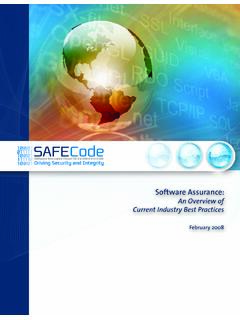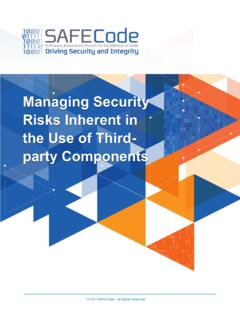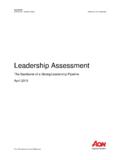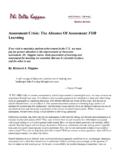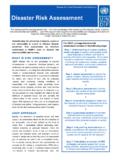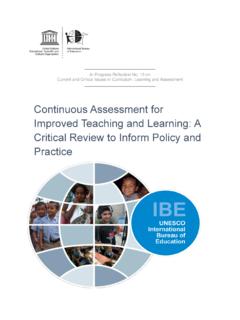Transcription of A Guide to the Most Effective Secure Development …
1 Fundamental Practices for Secure Software Development A Guide to the Most Effective Secure Development Practices in Use TodayOCTOBER 8, 2008 ContributorsGunter Bitz, SAP AGJerry Cochran, Microsoft Coles, EMC CorporationDanny Dhillon, EMC CorporationChris Fagan, Microsoft Goldschmidt, Symantec Higaki, Symantec Howard, Microsoft Lipner, Microsoft Corp. Brad Minnis, Juniper Networks, Parekh, EMC CorporationDan Reddy, EMC CorporationAlexandr Seleznyov, NokiaReeny Sondhi, EMC CorporationJanne Uusilehto, NokiaAntti V h -Sipil , NokiaEditor Stacy Simpson, SAFEC odeii Executive SummarySoftware assurance encompasses the Development and implementation of methods and processes for ensuring that software functions as intended while mitigating the risks of vulnerabilities and malicious code that could bring harm to the end user. Recognizing that software assurance is a vital defense in today s increasingly dynamic and complex threat environment, leading software vendors have under-taken significant efforts to reduce vulnerabilities, improve resistance to attack and protect the integrity of the products they sell.
2 These efforts have resulted in signifi-cant improvements in software security and thus offer important insight into how to improve the current state of software its analysis of the individual software assurance efforts of its members, SAFECode has identified a core set of Secure Development practices that can be applied across diverse Development environments to improve software security. It is important to note that these are the practiced practices employed by SAFE-Code members. By bringing these methods together and sharing them with the larger community, SAFECode hopes to move the industry beyond defining sets of often-cited, but rarely-used, best practices to describing sets of software engineer-ing disciplines that have been shown to improve the security of software and are currently in common practice at leading software companies. Using this approach enables SAFECode to encourage the adoption of best practices that are proven to be both Effective and implementable even when different product requirements and Development methodologies are taken into key goal of this paper is to keep it short, pragmatic and highly actionable.
3 It prescribes specific security practices at each stage of the Development process Requirements, Design, Programming, Testing, Code Handling and Documentation that can be implemented across diverse Development vendors have both a responsibility and business incentive to ensure product assurance and security. SAFECode has collected, analyzed and released these security best practices in an effort to help others in the industry to initiate or improve their own software assurance programs and encourages the industry-wide adoption of the Secure Development methods outlined in this Table of Contents Overview 2 Requirements 3 Design 4 Programming 6 Testing 16 Code Integrity and Handling 18 Documentation 19 Conclusion 19 About SAFECode 202 Overview of Best Practices for Secure Software DevelopmentThere are several different software Development methodologies in use today. How-ever, they all share common elements from which we can build a nearly universal framework for software review of the security-related disciplines used by the highly diverse SAFECode members reveals that there are corresponding security practices for each stage of the software Development lifecycle that can improve software security and integrity, and are applicable across diverse environments.
4 The examination of these ven-dor practices reinforces the assertion that software assurance must be addressed throughout the software Development lifecycle to be Effective and not treated as a one-time event or single box on a check list. Moreover, all of these security prac-tices are currently being used by SAFECode members, a testament to their ability to be integrated and adapted into real-world Development environments even when unique product requirements are taken into practices defined in this document are as diverse as the SAFECode member-ship, spanning web-based applications, shrink-wrapped applications, database applications as well as operating systems and embedded systems. To aid others within the software industry in adopting and using these software assurance best practices effectively, this paper describes each identified security practice across the software Development lifecycle and offers implementation advice based on the experi-ences of SAFECode paper describes each identified security practice across the software devel-opment lifecycle and offers implementation advice based on the experiences of SAFECode RequirementsDuring requirements definition, a set of activities is defined to formalize the security require-ments for a specific product release.
5 These practices identify functional and non-functional requirements, and include conducting a product or code-specific risk assessment, identifying specific security requirements to address the identified risks, and defining the security Development roll-out plan for that release. The product Development team first identifies security requirements from use cases, cus-tomer inputs, company policy, best practices and security improvement goals. Then, the team prioritizes security requirements based on threat and risk levels such as threats to code integrity, intellectual property protection, personally-identifiable information (PII) or sen-sitive data, features that require admin/root privileges and external network security engineering requirements help drive design, programming, testing, and code handling activities similar to those outlined in the rest of this document.
6 It is also use-ful to review security requirements that were deferred from the previous release and priori-tize them with any new requirements definition, it is important that the product managers and other business leaders who allocate resources and set sched-ules are aware of the need to account for time to engage in Secure Development practices. Awareness training and return on investment arguments help present the business case for Secure Development . It is important that these decision-makers understand the risks that their customers will have to accept should too little effort be put into Secure preparation for each product release, the Development and QA staff members should be trained in Secure Development and testing. Training goals help track and drive improve-ment in this security requirements cover areas such as:Staffing requirements (background verification, qualifications, training and education, etc.)
7 Policy on disclosure of information and project confidentialityAuthentication and password managementAuthorization and role management Audit logging and analysis Network and data security Third party component analysis Code integrity and validation testing Cryptography and key management Data validation and sanitization Serviceability Ongoing education and awareness 4 DesignThe single Secure software design practice used across SAFECode members is threat analysis, which is sometimes referred to as threat modeling or risk analy-sis. Regardless of the name, the process of understanding threats helps elevate potential design issues that are usually not found using other techniques such as code reviews and static source analyzers. In essence, threat analysis helps find issues before code is committed so they can be mitigated as early as possible in the software Development lifecycle. For example, rather than wait for an analysis tool to potentially find injection vulnerabilities, it s better for a Development team to realize that their product may be vulnerable to these issues and put in place defenses and coding standards to reduce the risk from the an organization does not have expertise in building threat models, a free-form discussion is better than not thinking at all about potential application weaknesses.
8 Such brainstorming should not be considered a complete solution, and should only serve as a stepping stone to a more robust threat analysis risk of not doing an adequate job of identifying architectural and design security flaws is that customers, researchers or attackers may find these flaws which would then require a major upgrade or re-architecture effort to mitigate the resulting vulnerability an extremely costly SAFECode members have adopted misuse cases to help drive their under-standing of how attackers might attack a get the full benefit of threat modeling while designing the software, software designers and architects should strive to mitigate any identified issues before moving beyond design whenever possible. Comprehensive treatment of mitigation techniques is beyond the scope of this paper, but most Secure design practices today are based on the fundamental work by Saltzer and members also recommend selecting standard, proven security toolkits, such as cryptographic and protocol libraries, during the requirements or design phase and advise Development groups to avoid building their own security tech-nologies and protocols.
9 5 ResourcesThe Security Development Lifecycle. Chapter 9, Stage 4: Risk Analysis Microsoft Press, Howard & Protection of Information in Computer Systems. Proceedings of the IEEE, 63(9):1278 1308, September 1975. Saltzer and Security Assurance: State-of-the-Art Report. Section , Threat, Attack, and Vulnerability Modeling and Assessment Information Assurance Technology Analysis Center (IATAC), Data and Analysis Center for Software (DACS).Security Mechanisms for the Internet. Bellovin, Schiller, Kaufman; Security Requirements through Misuse Cases , Sindre and Opdahl; ProgrammingThroughout programming, the following practices are used across the majority of SAFECode members: Minimize unsafe function use Use the latest compiler toolset Use static and dynamic analysis tools Manual code review Validate input and output Use anti-cross site scripting libraries Use canonical data formats Avoid string concatenation for dynamic SQL Eliminate weak cryptography Use logging and tracing These practices are detailed on the following Minimize unsafe function useBuffer overrun vulnerabilities are a common and easy-to-introduce class of vulnerability that primarily affects C and C++.
10 An analysis of buffer overrun vulnerabilities over the last ten years shows that a common cause is using unsafe string- and buffer-copying C runtime functions. Functions such as, but not limited to, the following function families are actively discouraged by SAFECode members in new C and C++ code, and should be removed over time from older code. Development engineers can be trained to avoid using these function calls, but using tools to search the code for these calls helps validate the training efforts and identify problems in legacy code. Building the execution of these tools into the normal compile/build cycles relieves the developers from having to take special efforts to meet these , it is important to be aware of library or operating system specific versions of these functions. For example Windows has a func-tional equivalent to strcpy called lstrcpy and Linux has strcopy, to name but a few, and these too should be Development Lifecycle (SDL) Banned Function Calls; and strlcat Consistent, Safe, String Copy and Concatenation, Miller & de Raadt; Families to Remove:strcpy family strncpy family strcat family strncat family scanf family sprint family gets family 8 When possible, use the latest compiler toolset to take advantage of compile-time and run-time defensesAs previously noted, a very common and dangerous type of vulnerability that primarily affects code written in C or C++ is the buffer overrun.
